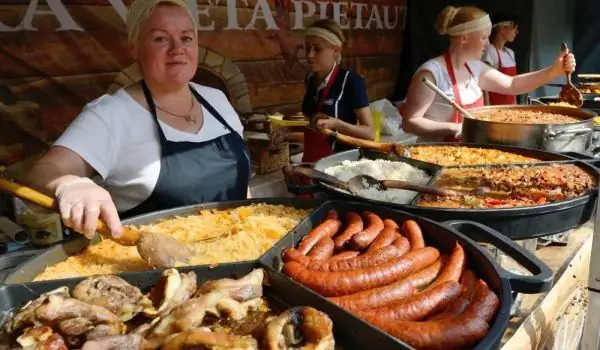2025 Author: Jasmine Walkman | [email protected]. Last modified: 2025-01-23 10:18
Israeli cuisine is characterized by predominantly Jewish dishes left over from the local population or brought in by Jewish immigrants from around the world. The establishment of Israeli cuisine as we know it today took place mostly in the period after 1970.
Jewish cuisine has been strongly influenced by hard life. Since the Middle Ages, most Jews have lived in ghetto Europe as a landless class. Jewish women with a lot of imagination managed to prepare dishes from the small number of products available to them.
Dishes in Jewish cuisine are united by the laws of kashrut. From the Hebrew the word kashrut translates as fit and means a certain set of rules that must be followed when preparing food.
For example, it is forbidden to mix dairy and meat foods. Meat from non-ruminants that do not have a forked hoof (such as a pig) as well as meat from predators and birds is prohibited. Seafood is prohibited. Only fish with fins and scales can be used.

Israeli culinary traditions are associated with foods and cooking methods that have taken shape over the past three thousand years. During this time, these traditions were influenced by Asia, Africa and Europe, but they also have many religious and ethnic influences.
Each district in Israel is characterized by its own variety of crops grown on its territory. In the coastal areas, more lemons, oranges and grapefruits grow, while in cooler places, mostly figs, pomegranates and olives are grown.
Interestingly, Israel does not have a universally recognizable national dish, although most people consider falafel to be such.
Vegetable salads are very common in the local cuisine and are consumed with almost every dish, including the traditional Israeli breakfast. It also includes eggs, bread and dairy products such as yogurt and cottage cheese.

The alluring taste of Israeli cuisine is also associated with some important technological features. Avoid frying. Most often, food is stewed, boiled or baked in the oven. Appetizers are especially revered at the expense of soups. Before the main course, several salads and various vegetable appetizers are usually served.
Try Baba Ganush, Israeli egg soup, Falafel with coriander, Shakshuka, Homemade falafel, Hummus salad, Hummus with eggplant, Hummus according to the original recipe, Hummus with roasted peppers.
Recommended:
Culinary Traditions In Lithuania

Lithuania is the southernmost and largest of the three Baltic States. It is located on the southeast coast of the Baltic Sea. The country borders Latvia to the north, Belarus to the southeast, and Poland and Russia to the southwest. Lithuanian belongs to the group of Indo-European languages and is spoken by about 4,000 people in Lithuania.
Culinary Traditions In Denmark

The Danish culinary tradition is determined by the geographical location of the country. Main products are potatoes, barley, rye, beets, turnips, mushrooms. Both fish and seafood are widespread. Breakfast usually consists of coffee or tea and rye or white bread with cheese or jam.
Turkish Culinary Traditions - Interesting Facts

To be able to look a little deeper into the culinary traditions of Turkey , we will have to introduce you to at least a few sentences and its story with the promise not to bore you. Like many other peoples, the Turks were once nomads. They traveled from one place to another and did not stay anywhere for too long.
Culinary Traditions In Australia

Seen from Eastern Europe, Australia looks distant and exotic. The same can be said for her cuisine, rich in meat, seafood and unfamiliar fish. Today, the continent of Australia is inhabited by immigrants from around the world, each group preserving its culinary traditions and customs.
The Magic Of Spanish Culinary Traditions

Spain attracts millions of tourists with its historical monuments, rich nature, amazing climate and of course - its cuisine. The cuisine of modern Spain not much different from the old, original, simple and delicious in a rustic Spanish cuisine.

